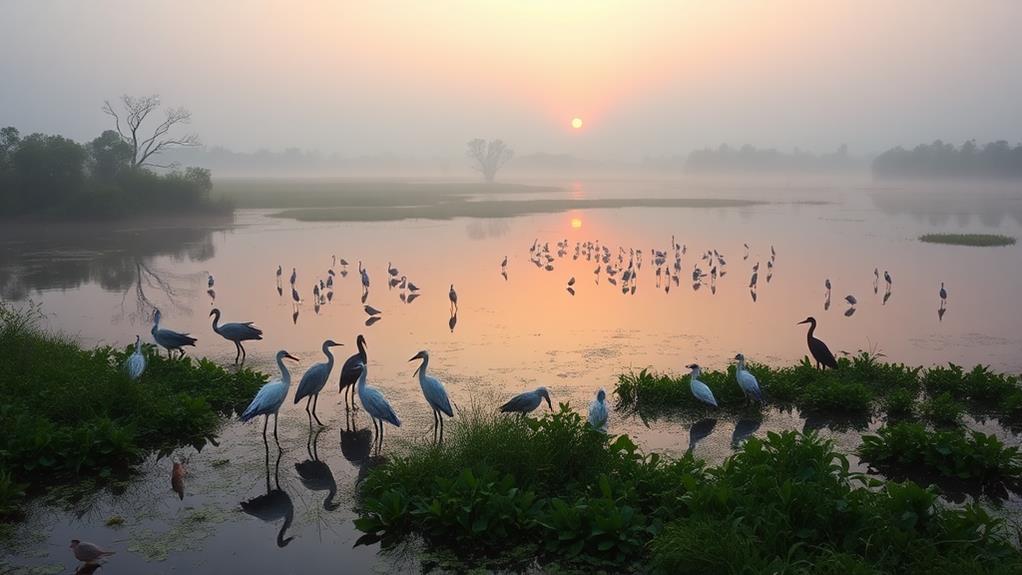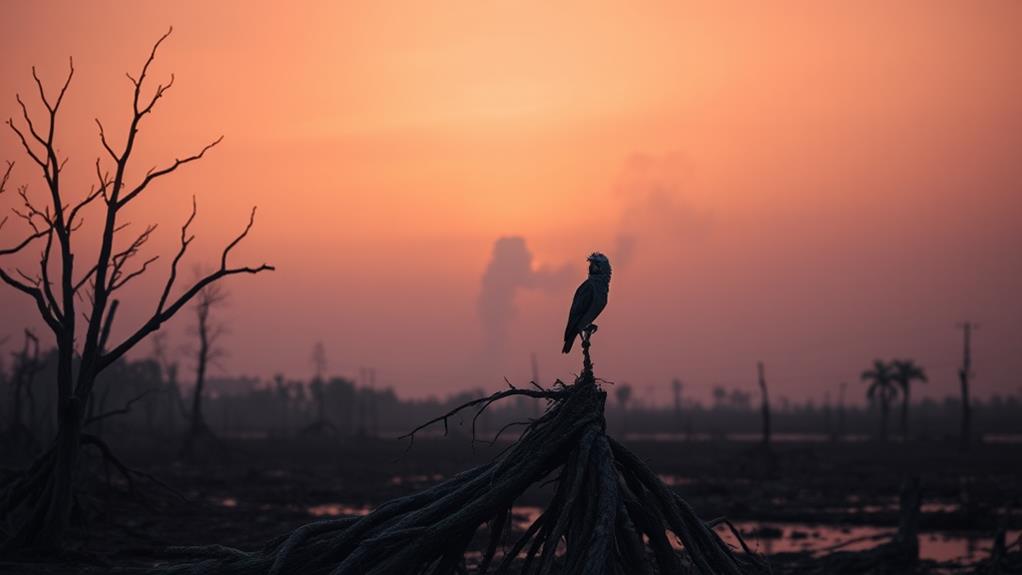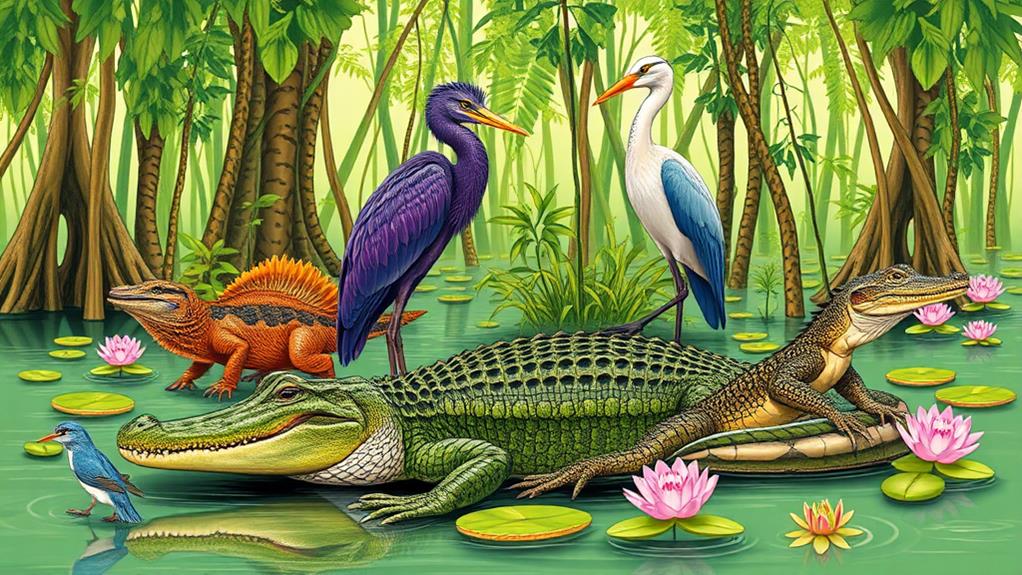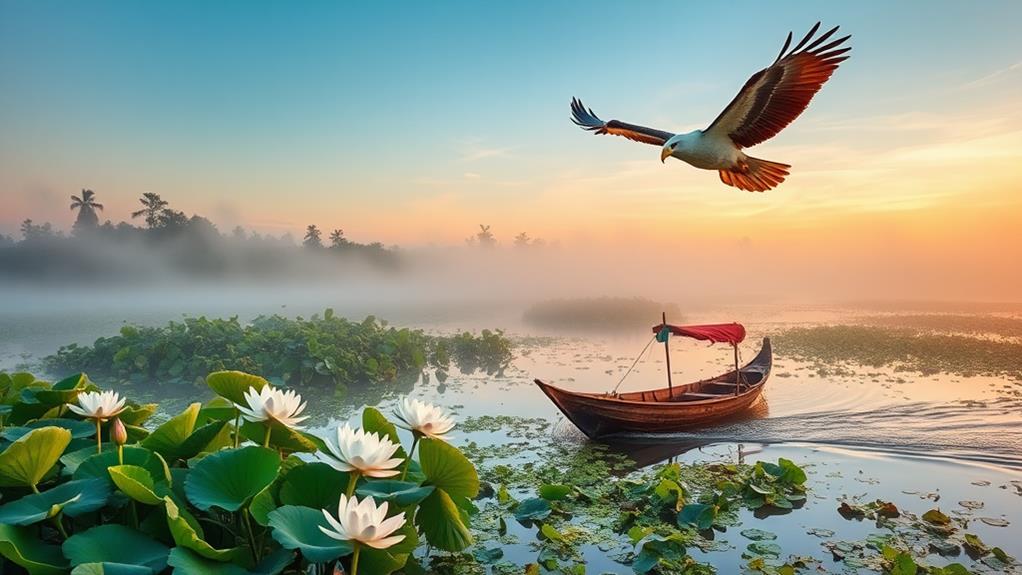Agusan Marsh Wildlife Sanctuary is a 40,954.745-hectare wetland ecosystem in the Philippines. This vast sanctuary supports diverse habitats like marshes, rivers, and lakes, which are home to over 1,100 species of flora and fauna.
The sanctuary is a haven for birdwatchers, with 127 bird species, including the threatened silvery kingfisher. Additionally, it is home to 14 freshwater fish species.
Unique habitats, such as Sago and Peat Swamp Forests, play a critical role in the ecosystem. These habitats are essential for nutrient cycling, erosion control, and climate adaptation.
The Agusan Marsh Wildlife Sanctuary is a treasure trove of ecological wonders, and its rich biodiversity makes it a significant area for conservation and exploration. The sanctuary is home to a diverse range of species, including rare and endemic fauna such as the Philippine duck and the Philippine eagle. Additionally, the Agusan Marsh encompasses not only wetlands, but also mossy forest ecosystems, providing a variety of habitats for countless plant and animal species. As a result, it is a vital area for scientific study and research, as well as a popular destination for eco-tourism and nature enthusiasts.
Wetland Ecosystem Overview

The Agusan Marsh Wildlife Sanctuary is a vast and intricate wetland ecosystem that covers 40,954.745 hectares, making it the largest and least disturbed freshwater wetland in the Philippines.
This ecosystem supports a diverse range of habitats, including freshwater marshes, rivers, and lakes, which are home to over 1,100 species of flora and fauna.
The sanctuary is a haven for birdwatchers, with 127 bird species, including the threatened silvery kingfisher.
Freshwater fish species also thrive here, with 14 species found in the marsh.
The unique habitats within the marsh, such as Sago and Peat Swamp Forests, play a crucial role in nutrient cycling, erosion control, and climate adaptation mechanisms.
Wetland ecosystems like Agusan Marsh serve as a natural flood control system and store more than 15% of the nation's freshwater resources.
This highlights the critical biodiversity and ecological significance of these ecosystems, which are essential for maintaining the balance of nature.
Importance of Wetlands Globally
Wetlands are a vital part of a global network that provides essential ecological services. They cover around 6% of the Earth's surface and support nearly 1 billion people who rely on them for their livelihoods, such as fishing and farming.
For example, the Agusan Marsh Wildlife Sanctuary in the Philippines is a significant wetland that provides a habitat for various species and supports local communities.
Wetlands act as natural filters, improving water quality by trapping sediments and pollutants. This process enhances ecosystem health and biodiversity. In fact, approximately 40% of species breed in wetlands or use them as nurseries, highlighting their crucial role in maintaining biological diversity.
The Yellow Wetlands in Africa, for instance, serve as a breeding ground for millions of migratory birds.
Wetlands also store significant amounts of carbon, acting as carbon sinks that help mitigate climate change. Wetlands store around 30% of the world's carbon, which is crucial in reducing greenhouse gas emissions.
Unfortunately, since the Ramsar Convention was established in 1971, over 35% of global wetlands have been lost, disappearing at a rate three times faster than forests. This emphasizes the urgent need for conservation efforts to ensure food security and mitigate the impacts of climate change.
Threats to Agusan Marsh

Within the Agusan Marsh Wildlife Sanctuary, various human activities and natural phenomena threaten the fragile ecosystem, jeopardizing the very existence of this vital wetland.
Agricultural expansion and development projects compromise the marsh's ecological balance by draining peatlands and swamp forests. This destruction of natural habitats has severe consequences for the marsh's biodiversity.
The growth of invasive water hyacinth obstructs waterways, affecting traditional fishing practices. Climate variability exacerbates this problem by promoting the growth of water hyacinth, further disrupting the marsh's ecosystem.
Pollution from palm oil plantations significantly degrades water quality in Agusan Marsh, posing a threat to the health of its ecosystems and the livelihoods of local communities, including the Manobo Indigenous tribe.
Climate change and extreme weather events, such as catastrophic floods and droughts, undermine the health and livelihoods of the Manobo Indigenous community, who rely on the marsh's water levels.
These events have devastating consequences for the community's well-being.
It is essential to address these threats to preserve the Agusan Marsh's biodiversity and the well-being of its inhabitants.
Community Impact and Significance
The Agusan Marsh Wildlife Sanctuary is vital to the Indigenous Manobo community, who rely on its natural resources for their livelihood. The community's cultural practices are deeply intertwined with the wetland ecosystem, and their spiritual connection to the land is reflected in their rituals and prayers for the marsh's wellbeing.
Fishing and sustainable livelihoods are essential resources provided by the Agusan Marsh. These resources are shared among families to enhance food security, but the community faces increasing threats from climate change and agricultural expansion, jeopardizing their traditional way of life and access to vital wetland resources.
Pollution from nearby palm oil plantations poses a significant risk to the community's health and the biodiversity they rely on for sustenance. The decline in water quality due to pollution is a major concern.
Recognizing the integral role wetlands play in the Manobo identity, conservation efforts must prioritize indigenous rights and cultural ties to the ecosystem. By doing so, we can ensure the long-term preservation of the Agusan Marsh's rich biodiversity.
Conservation Strategies Needed

Conservation of the Agusan Marsh Wildlife Sanctuary's unique ecosystem requires a multifaceted approach.
The sanctuary's conservation demands addressing habitat destruction, biodiversity loss, and recognizing indigenous rights.
To ensure the long-term sustainability of Agusan Marsh's ecosystems and biodiversity, the following conservation strategies are necessary:
Granting indigenous rights is crucial. The Manobo community has deep cultural ties to the marsh and relies on its resources for their livelihoods.
Legal rights must be granted to the Manobo community.
Collaborative conservation efforts are essential. Involving local communities, NGOs, and government bodies in conservation efforts ensures a unified approach.
Partnerships between these stakeholders will facilitate effective conservation.
Protected area management is vital. A framework for stronger protection and restoration efforts must be established within the 40,954.745-hectare sanctuary.
A comprehensive management plan will safeguard the sanctuary's ecosystems.
Urgent action is needed to protect threatened species. Immediate steps must be taken to prevent further decline in species populations, particularly the 11 threatened bird species identified within the area.
Conservation efforts must prioritize the protection of these species.
Unique Flora and Fauna Found
Native Tree Species Abound
The Agusan Marsh Wildlife Sanctuary is home to 112 tree species, with an impressive 93% being native to the Philippines.
Moreover, 16 vascular plant species found in the sanctuary are found nowhere else in the world.
Diverse Bird Life
The marsh is a haven for bird species, with a total of 127 species documented.
67 of these species are endemic to the Philippines, and 48 are specifically found in Mindanao.
Furthermore, 10 of these bird species are threatened, highlighting the sanctuary's critical role in their conservation.
Unique Fauna
The Agusan Marsh is also home to unique fauna, including the freshwater crocodile and the Philippine sailfin lizard.
The discovery of the Pacific Reef Heron at Lake Panlabuhan underscores the marsh's importance as a habitat for diverse avian life.
The ecosystem is home to 34 reptile species, with 11 being endemic, illustrating the marsh's rich biodiversity and ecological significance.
Featured Wetland Conservation Members

Featured Wetland Conservation Members
Several organizations within the Wetland Link International (WLI) network are dedicated to advancing wetland conservation efforts in the Agusan Marsh Wildlife Sanctuary.
Diverse Organizations Unite for Conservation
The WLI network comprises a range of organizations, including educational institutions like Danapure, which focuses on wetland conservation efforts, and the Wasit Wetland Center, which promotes awareness about wetland ecosystems.
Species-Specific Conservation Initiatives
The Pheasant-tailed Jacana Conservation Park is a prime example of species-specific conservation, dedicated to preserving the Pheasant-tailed Jacana species. This highlights the importance of targeted conservation initiatives within the network.
Global Network for Wetland Conservation
WLI members span multiple countries and regions, representing a variety of organizations including NGOs and government bodies. This global network unites organizations in their mission to conserve wetlands and promote sustainable management.
Collaborative Conservation Efforts
Members benefit from the global network, which facilitates collaboration on conservation projects, sharing resources, and engaging in community efforts to protect wetland ecosystems.
This collective approach strengthens conservation initiatives in the Agusan Marsh Wildlife Sanctuary.
Global Wetland Awareness Matters
Wetlands are vital ecosystems that require global awareness and conservation efforts.
Wetlands support nearly 1 billion people worldwide, providing essential resources for livelihoods, food security, and biodiversity. 40% of species breed or use wetlands as nurseries, highlighting their critical role in maintaining global biodiversity and ecosystem health.
The importance of wetlands is underscored by alarming conservation statistics. Since 1971, wetlands have been lost at a rate 3 times faster than forests, with a staggering 35% decline. This loss has severe consequences, including an additional $33,000 in storm damage costs per hectare lost.
Raising awareness about wetland importance can lead to increased conservation efforts. The Ramsar Convention, a global movement, aims to value and protect wetlands as vital components of our environmental and cultural heritage.
Recognizing the legal rights of wetlands, as proposed by recent studies, can further enhance conservation efforts.
Every individual can contribute to protecting these vital ecosystems for future generations. By recognizing the significance of wetland conservation, we can work together to maintain biodiversity and ensure food security.
What are the main features of the Agusan Marsh Wildlife Sanctuary that contribute to its rich biodiversity?
The Agusan Marsh Wildlife Sanctuary is known for its diverse flora and fauna. Its vast wetlands, freshwater habitats, and abundant aquatic resources make it a haven for a variety of species. The interconnected ecosystem of the sanctuary provides a conducive environment for sustaining life, making it a thriving marine sanctuary with diverse coral reefs.
How Does Apo Reef Compare to Agusan Marsh in Terms of Biodiversity?
Apo reef marine sanctuary diverse corals create an underwater haven teeming with vibrant marine life, showcasing its exceptional biodiversity. In contrast, Agusan Marsh thrives as a rich wetland ecosystem, home to hundreds of bird species and unique freshwater fauna. Both destinations highlight the Philippines’ natural wonders, each remarkable in its own unique way.
Protecting Wetlands for the Future

Protecting Wetlands for the Future
The world's precious wetlands, like the Agusan Marsh Wildlife Sanctuary, need urgent conservation efforts to prevent further destruction. Since 1971, over 35% of global wetlands have been lost, with wetlands disappearing at three times the rate of forests.
Recognize Indigenous Rights
Effective conservation requires incorporating the rights of Indigenous communities, like the Agusan Manobo, whose livelihoods depend on the marsh. This is crucial because Indigenous peoples have traditional knowledge and practices that can aid conservation efforts.
Implement Sustainable Land-Use Practices
Pollution from agriculture, particularly palm oil plantations, has compromised water quality in Agusan Marsh. To address this, sustainable land-use practices must be implemented to reduce pollution and protect wetland ecosystems.
Restore Habitats
Comprehensive habitat restoration approaches are essential to maintaining biodiversity and ecological balance in wetlands like Agusan Marsh.
Restoration efforts should prioritize native plant species and natural habitats to support local wildlife.
Grant Legal Rights to Wetlands
Recent proposals to grant legal rights to wetlands reflect a global shift towards recognizing the intrinsic value of these ecosystems in climate strategy and biodiversity conservation.
Granting legal rights to wetlands can provide a legal framework for their protection, ensuring their preservation for future generations.
Frequently Asked Questions
What Is the Problem With the Agusan Marsh?
The Agusan Marsh faces significant threats to its survival. Habitat destruction and pollution are major concerns, primarily caused by agricultural expansion and deforestation. For instance, the conversion of marshland into agricultural areas leads to soil erosion and increased sedimentation in waterways.
Climate change disrupts local ecosystems and indigenous communities by altering water levels and temperature, which affects the marsh's natural habitats and the people who depend on them.
Moreover, limited community involvement and inadequate sustainable practices hinder effective management and conservation of the marsh.
Invasive species, such as water hyacinth, clog the marsh's waterways, obstructing access to resources and affecting the local biodiversity.
Furthermore, limited financial resources and personnel restrict conservation efforts, making it challenging to address the marsh's environmental issues.
What Is the Biodiversity of the Wetlands Ecosystem?
The wetland ecosystem is home to a remarkable 1,100 species of flora, with 314 species endemic to the region, highlighting its ecological significance.
The wetland's aquatic fauna is equally diverse, with 14 species of freshwater fish, 39 species of reptiles, and 21 species of amphibians thriving in this habitat.
To preserve this rich biodiversity, conservation strategies must prioritize habitat preservation.
What Is the Proclamation on the Agusan Marsh Wildlife Sanctuary?
The Agusan Marsh Wildlife Sanctuary was established in 1996 to protect its unique wetland ecosystem. This conservation effort recognizes the area's ecological significance as a habitat for various species and indigenous communities, such as the Manobo tribe.
The sanctuary promotes sustainable tourism and habitat protection to preserve its biodiversity. By doing so, it maintains the delicate balance of the ecosystem, benefiting both the environment and local communities.
What Is the Largest Wetland in the Philippines?
The Agusan Marsh in Mindanao is the largest wetland in the Philippines, covering an area of approximately 14,000 hectares.
This ecosystem is vital for wetland conservation, providing a habitat for numerous indigenous species, such as the critically endangered Philippine crocodile and the Philippine cockatoo.
Preserving this habitat supports climate resilience and protects biodiversity, which is essential for maintaining ecological balance.
The unique features of the Agusan Marsh make it a crucial area for scientific study and conservation efforts, ultimately benefiting the environment and local communities.